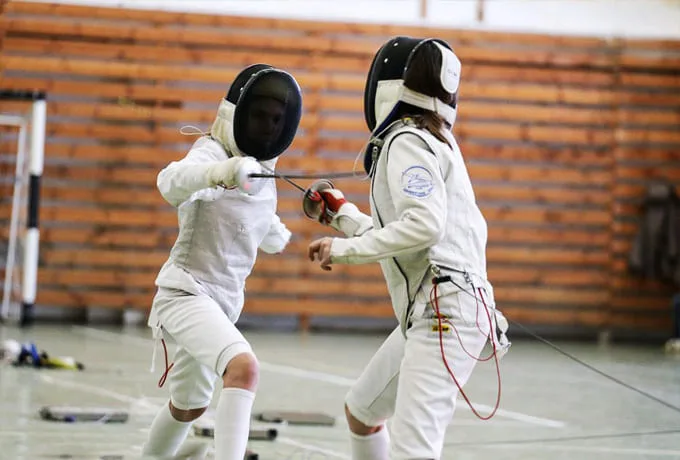
Fencing is one of the oldest forms of combat sports, originating in Europe during the Middle Ages. Over time, it developed into a modern sport combining agility, strategy, and speed. Fencing became particularly popular in the 19th century, when it was included in the first modern Olympic Games in 1896. The sport’s appeal lies in its blend of physical and mental challenge, as participants must not only be swift with their movements but also quick in their decision-making. The art of fencing draws from historical sword-fighting techniques, evolving into a disciplined, competitive sport practiced globally.
Today, fencing is seen as both a professional sport and a popular recreational activity. It attracts a wide range of participants, from children to adults, due to its dynamic nature and the minimal risk of serious injury when proper protective gear is worn. Modern fencing includes three main disciplines, which have contributed to its enduring appeal and global presence in competitive sports.
What types of fencing are there?
There are three main types of fencing: foil, épée, and sabre, each with its own unique rules and equipment. The foil is a lightweight weapon, with points awarded for strikes to the torso. In foil fencing, only the tip of the blade can score, and the action is fast-paced, with competitors aiming for precision. Épée is a heavier sword, and points can be scored anywhere on the opponent’s body. This style encourages a more defensive approach, as participants must carefully plan their strikes. Finally, sabre is distinct in that both the tip and the blade can score, with points awarded for hits above the waist. Sabre fencing is the most aggressive of the three disciplines, relying heavily on speed and swift reactions.
Each type of fencing offers a different tactical experience. While foil demands precision and patience, épée requires thoughtful defense, and sabre calls for fast, assertive movements. Many fencers specialize in one discipline, though it is common for athletes to train in all three at various points in their careers.
What you need to know before taking up this sport?
Before starting fencing, it’s important to be aware of the physical and mental demands of the sport. Although fencing is accessible to beginners, it requires a good level of physical fitness and coordination. The sport involves quick, explosive movements, and participants need to be agile and flexible. Proper warm-ups and stretches are essential to prevent injuries, as fencing can put strain on the legs and back.
Additionally, fencing is a sport that requires strategic thinking. Matches are often won through careful planning and the ability to outthink opponents, so it’s important to develop a keen sense of tactics alongside physical skills. Beginners should also be prepared to invest in equipment, which includes a mask, protective clothing, and the appropriate fencing weapon.
Joining a fencing club is highly recommended for beginners. It offers the opportunity to receive guidance from experienced coaches, practice with other fencers, and gain access to professional-grade equipment. Moreover, learning fencing in a structured environment helps new fencers develop the discipline and respect that are central to the sport.

How difficult is this hobby?
Fencing can be challenging, but it is also incredibly rewarding. The sport demands both physical stamina and mental focus, as fencers must constantly be aware of their own movements and their opponent’s strategies. Mastering fencing techniques takes time, and beginners often find the footwork to be particularly tricky. However, with regular practice and dedication, most individuals can make significant progress within a few months of starting.
The complexity of fencing lies in its blend of speed, precision, and timing. Even though it may seem difficult at first, fencing is a sport that builds skills incrementally. Beginners can start with basic drills to improve their coordination and gradually move on to more complex techniques. The constant interplay between attack and defense requires concentration and the ability to adapt quickly, making fencing a mentally stimulating activity.
It’s also worth noting that fencing can be physically demanding. It requires agility, strength, and endurance, especially during long matches. However, the sport is suitable for a wide range of ages and fitness levels, and fencers often tailor their training to their own abilities.
Despite the challenges, fencing is an enjoyable and fulfilling hobby for many. The satisfaction of mastering new techniques, combined with the thrill of competition, makes it a sport that consistently engages both the mind and body.
Is it worth taking up this hobby?
Fencing is an excellent hobby for those who enjoy a blend of physical activity and mental challenge. It promotes agility, focus, and strategic thinking, all while providing a full-body workout. Moreover, the sense of community within fencing clubs can enhance the experience, offering social connections alongside physical benefits.
For those looking to stay active while honing their mental acuity, fencing is a perfect match. Its structured yet dynamic nature ensures that participants are always learning and improving, making it a hobby that keeps both body and mind sharp. Additionally, fencing is relatively low-risk in terms of injury compared to other combat sports, thanks to the protective gear and the strict rules enforced during matches.
Overall, fencing is worth taking up for anyone seeking a new and engaging form of recreation. Whether you’re interested in competitive sports or simply looking for a fun way to stay fit, fencing offers a unique and rewarding experience.